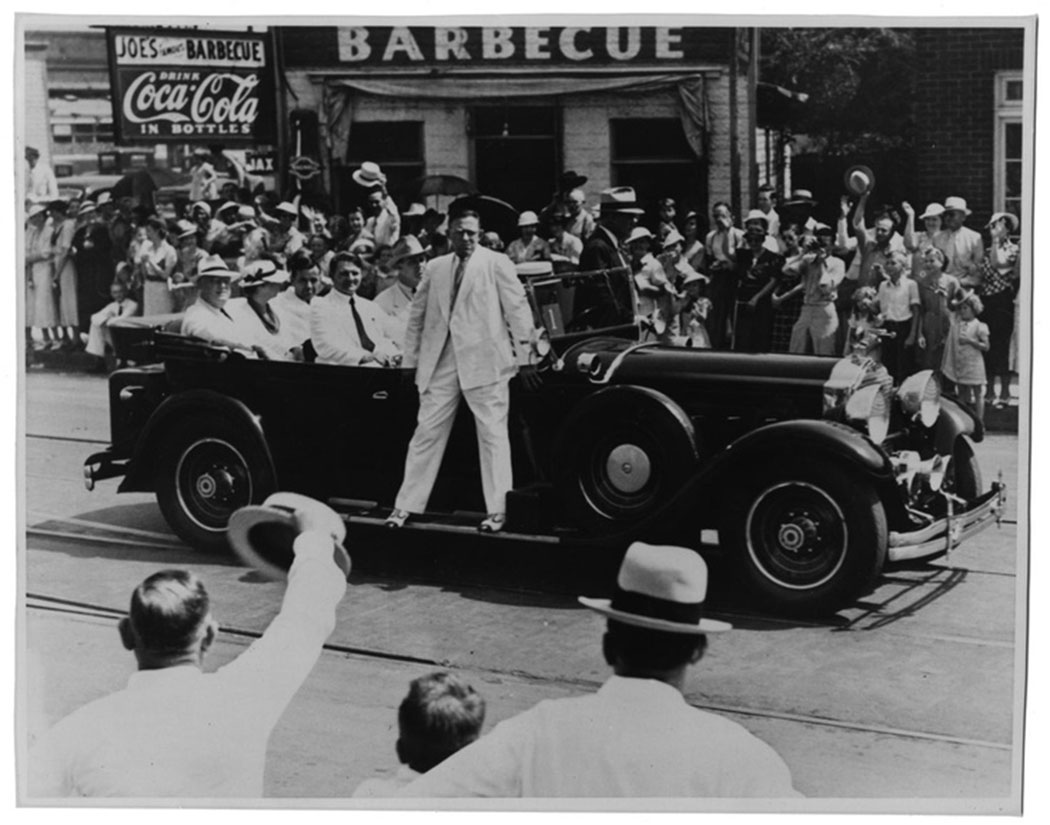
Dallas Mayor George Sergeant rides in the front passenger seat of the President’s car. Behind him are FDR and First Lady Eleanor Roosevelt. Photo courtesy of Jim Lake Jr.
A presidential motorcade through downtown Dallas went much smoother in 1936.
President Franklin D. Roosevelt arrived in Dallas June 11, 1936 as part of a tour of the state for the Texas Centennial celebration. His convertible, with secret service officers on the running boards, left the Adolphus Hotel at 9:30 a.m. the following day. Also in the car were First Lady Eleanor Roosevelt and their host, Dallas Mayor George Sergeant.
Sergeant, who lived on Zang Boulevard just north of Davis, served as Dallas mayor for one two-year term. But it was an eventful two years.
Sergeant was an old-school Southern conservative and teetotaler who led a campaign on vice. A world traveler, he had served for years as a district judge when he was elected to city council in 1935. Back then, a majority of council members voted in the mayor.
According to a newspaper story published before the election, Sergeant had traveled to Europe, Asia, Canada, Alaska and Mexico. The story compared him to legendary Texan Sam Houston.
“Mr. Sergeant spent part of his life among the Indians,” the story stated. “When he was a boy of 16, he went to live among the Cheyenne and Arapaho Indians in Oklahoma, spending part of 1898-99 among these early Americans.”
Sergeant took office with a whole new city council. The first priority for this new council: All married women employed by the City of Dallas whose husbands had jobs would be fired.
This was during the Great Depression, and having a dual-income household was perceived as greedy. Local politicians spun the tale that “women whose husbands come for them every day in sedans” were bad citizens and worse homemakers.
About 20 married women worked for the city at the time. One unnamed city employee told the newspaper that she liked her job so much she would consider getting a divorce. Another woman said she worked while her husband stayed home to do housework, “including some of the laundry,” and care for their baby.
“Single women working in the city hall kept their mouths shut Monday as the tension of the situation increased,” the newspaper said.
[quote align=”right” color=”#000000″]The first priority for this new council: All married women employed by the City of Dallas whose husbands had jobs would be fired.[/quote]The city council voted for an ordinance banning married women from city employment in July 1935, and it didn’t stop there. Council also tried to enact the law retroactively as a way to skirt Civil Service Board rules that protected the women from being fired.When the women fought back, they were met with political threats.
“One Councilman answered … that those might be the ones to feel the ax first,” the newspaper reported.
The move set off a citywide discussion, which also was taking place nationally, about whether married women should hold jobs. This was the same year that Sarah T. Hughes, a married woman, was appointed to the Fourteenth District Court in Dallas, making her the first female district judge in Texas.
Sergeant, who had voted against the ban on wives, received a call of congratulations from Hughes.
About six weeks later, the city’s Civil Service Board found that the wife ban was against its rules, nullifying the sexist ordinance.
“The Civil Service Board is of the opinion that public servants in the service of the city of Dallas should be selected and retained solely on their efficiency…”
The 1935 city council had a couple of other top priorities. Among them: cut salaries. The city manager’s salary was cut from $13,500 to $10,000, a difference of about $50,000 in 2015 dollars. All of the city’s department heads received drastic pay cuts.
Another priority: Spend $20,000 on a statue of Gen. Robert E. Lee.
On the day Roosevelt visited Dallas, he toured the great State Fair of Texas. Then the delegation had lunch and drove to Lee Park, where the Confederate monument was dedicated before the President traveled on to Fort Worth.
Sergeant lived in Oak Cliff until his death in 1971. After that, his house on Zang fell to his son, and after the son’s death in 2009, to a caretaker. Real estate investor Jim Lake Cos. bought it in 2011, along with boxes of scrapbooks, letters (including a hand-written thank-you note from Eleanor Roosevelt), manuscripts and photo slides.
Jim Lake Jr. has plans to turn the house into a restaurant once he finds the right occupant. He thinks it should be called The Mayor’s House.




